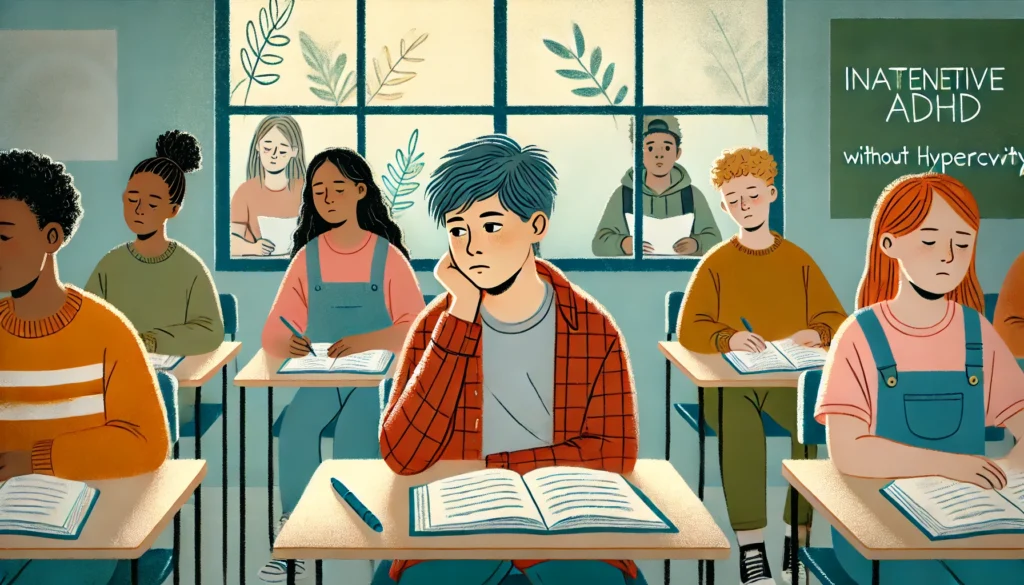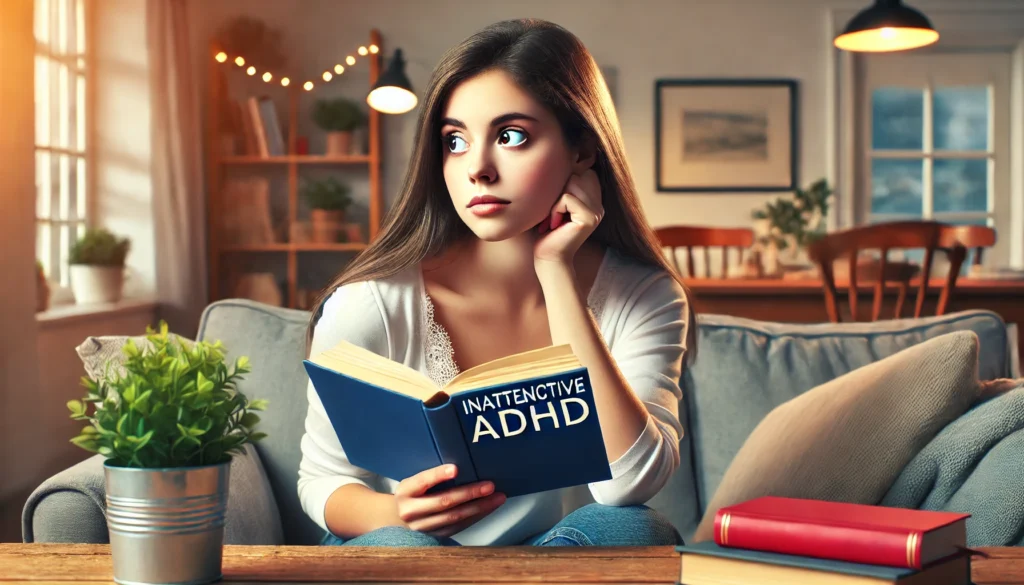The term “Inattentive ADHD” refers to one of the subtypes of Attention Deficit Hyperactivity Disorder (ADHD). Historically known as Attention Deficit Disorder (ADD), this condition is marked by symptoms such as forgetfulness, distractibility, and difficulty sustaining attention in tasks or play activities. Unlike its hyperactive counterpart, individuals with inattentive ADHD are less likely to display disruptive behaviors, which often leads to delayed diagnosis.
You may also like: Enhancing Concentration: Strategies for ADHD
Symptoms and Characteristics
Inattentive ADHD is characterized by several key symptoms that distinguish it from other ADHD subtypes. Individuals may struggle with sustained attention, often appearing forgetful in daily activities. They may also seem disorganized, frequently losing necessary items for tasks and activities. Despite the absence of hyperactivity, these symptoms can significantly impact daily functioning and quality of life.
Diagnosis Challenges
Diagnosing inattentive ADHD can be challenging due to its subtle presentation. Many individuals may not exhibit the disruptive behaviors typically associated with ADHD, leading to underdiagnosis. Comprehensive assessments involving clinical interviews, symptom checklists, and behavioral observations are essential in accurately identifying this subtype.
Impact on Daily Life
The effects of inattentive ADHD extend beyond academic or work-related tasks. Social interactions can also be affected, as individuals may appear disengaged or uninterested in conversations. Understanding the broader implications of inattentive ADHD is crucial for developing effective coping strategies and support systems.
Can You Have ADHD Without Hyperactivity?
A common question is whether one can have ADHD without exhibiting hyperactive behaviors. The answer is yes. Inattentive ADHD, or predominantly inattentive presentation, lacks the hyperactivity component that is typically associated with ADHD, focusing instead on attention-related issues.
Distinction from Hyperactive-Impulsive Type
While hyperactive-impulsive ADHD is marked by excessive movement and impulsive decision-making, inattentive ADHD primarily affects cognitive functions. Individuals with inattentive ADHD may daydream frequently, struggle with task completion, and have difficulty following instructions.
Overcoming Misconceptions
There is a common misconception that ADHD always involves hyperactivity. This misunderstanding can contribute to the stigma and underdiagnosis of inattentive ADHD. Raising awareness about the different presentations of ADHD can help individuals seek appropriate support and intervention.
The Role of Attention-Related Issues
Attention-related challenges are central to inattentive ADHD. These difficulties can manifest in various settings, including academic, professional, and social environments. Addressing these challenges requires targeted interventions that focus on improving attention and organizational skills.
ADD Without Hyperactivity in Adults
Adults with inattentive ADHD may struggle with maintaining focus at work, managing time, and organizing tasks. These challenges can result in significant professional and personal difficulties, underscoring the importance of recognizing and treating this condition effectively.
Workplace Challenges
Inattentive ADHD can pose unique challenges in the workplace. Adults may find it difficult to prioritize tasks, meet deadlines, and maintain consistent performance. Implementing organizational tools and time management strategies can enhance productivity and job satisfaction.
Managing Relationships
Interpersonal relationships can be affected by inattentive ADHD, as individuals may appear disengaged or forgetful. Open communication and understanding from partners, family members, and friends are essential for navigating these challenges and maintaining healthy relationships.
Pursuing Personal Goals
Adults with inattentive ADHD may face obstacles in pursuing personal goals due to difficulties with planning and follow-through. Setting realistic, achievable objectives and breaking them down into manageable steps can help individuals stay motivated and focused on their aspirations.

Historical Perspective and Current Trends
The understanding of ADHD has evolved significantly over the years. Initially, the focus was predominantly on hyperactive symptoms. However, growing awareness and research have highlighted the distinct nature of inattentive ADHD. Current trends emphasize a comprehensive approach to diagnosis and treatment, considering both behavioral and medical interventions.
Evolution of ADHD Understanding
The perception of ADHD has shifted considerably from its initial conceptualization. Early research primarily centered on hyperactive behaviors, often overlooking the inattentive subtype. Advances in psychological and neurological research have expanded the understanding of ADHD, recognizing it as a complex and multifaceted condition.
The Role of Research
Ongoing research plays a crucial role in advancing the understanding of inattentive ADHD. Studies focusing on the neurobiological and genetic underpinnings of ADHD have provided valuable insights into its diverse presentations. Continued research efforts are essential for developing more effective diagnostic tools and treatment approaches.
Comprehensive Diagnosis Approaches
Current trends in diagnosing ADHD emphasize a holistic approach that considers multiple factors. This includes evaluating behavioral patterns, cognitive functioning, and environmental influences. A comprehensive assessment is vital for accurately identifying inattentive ADHD and tailoring interventions to individual needs.
Treatment Options for Inattentive ADHD
Treatment for inattentive ADHD typically involves a combination of medication, behavioral therapy, and lifestyle modifications. Each treatment option aims to enhance focus, reduce distractions, and improve overall functioning.
Medication
Pharmacological treatments are often the first line of intervention for inattentive ADHD. Stimulants, such as methylphenidate and amphetamines, are commonly prescribed and have been shown to improve attention and concentration. Non-stimulant medications like atomoxetine and certain antidepressants may also be effective, particularly for individuals who cannot tolerate stimulants.
Stimulants
Stimulant medications are the most extensively studied and commonly used treatments for ADHD. They work by increasing the levels of certain neurotransmitters in the brain, thereby enhancing focus and attention.
Mechanism of Action
Stimulants enhance the activity of neurotransmitters like dopamine and norepinephrine, which play a key role in attention and cognitive function. By optimizing these neurotransmitter levels, stimulants can significantly improve focus and reduce distractibility.
Common Stimulant Medications
Commonly prescribed stimulant medications include methylphenidate (Ritalin, Concerta) and amphetamine-based drugs (Adderall, Vyvanse). These medications are available in various formulations, allowing for flexible dosing and tailored treatment plans.
Considerations and Side Effects
While stimulants are effective for many individuals, they may cause side effects such as increased heart rate, insomnia, and appetite suppression. Regular monitoring and communication with healthcare providers are essential to manage these potential side effects and adjust treatment as needed.
Non-Stimulants
Non-stimulant medications are a viable alternative for those who experience adverse effects from stimulants. Atomoxetine, for example, is a selective norepinephrine reuptake inhibitor that can aid in improving attention without the potential for abuse associated with stimulants.
Mechanism of Action
Non-stimulants like atomoxetine work by selectively inhibiting the reuptake of norepinephrine, a neurotransmitter involved in attention regulation. This mechanism provides a gradual and sustained improvement in focus and cognitive performance.
Popular Non-Stimulant Options
Atomoxetine (Strattera) is a widely used non-stimulant medication for ADHD. Other options include guanfacine (Intuniv) and clonidine (Kapvay), which are alpha-2 adrenergic agonists that can help manage symptoms of inattentive ADHD.
Advantages and Limitations
Non-stimulants offer several advantages, including a lower risk of abuse and a more gradual onset of effects. However, they may take longer to show benefits compared to stimulants, and individual responses can vary. Collaborative decision-making with healthcare providers is essential for determining the most suitable treatment.

Behavioral Therapy
Behavioral therapy is an essential component of a comprehensive treatment plan for inattentive ADHD. Cognitive Behavioral Therapy (CBT) is particularly effective in helping individuals develop strategies for managing symptoms, such as improving organizational skills and coping with stress.
Cognitive Behavioral Therapy (CBT)
CBT focuses on identifying and changing negative thought patterns that can exacerbate symptoms. By fostering skills for time management, organization, and planning, CBT can significantly alleviate the challenges associated with inattentive ADHD.
Techniques and Strategies
CBT employs various techniques, such as cognitive restructuring, goal setting, and problem-solving. These strategies empower individuals to challenge negative thoughts, develop adaptive behaviors, and enhance their ability to cope with ADHD-related challenges.
Benefits of CBT
CBT offers numerous benefits, including improved self-awareness, enhanced coping skills, and increased self-efficacy. By addressing cognitive and behavioral aspects of inattentive ADHD, CBT can lead to lasting improvements in daily functioning and quality of life.
Combining CBT with Other Treatments
Combining CBT with medication and lifestyle modifications can enhance treatment outcomes for inattentive ADHD. An integrated approach addresses multiple facets of the condition, providing comprehensive support for individuals seeking symptom relief and improved well-being.
Parent and Family Involvement
Involving parents and family members in therapy can be beneficial, especially for children and adolescents with inattentive ADHD. Family therapy and psychoeducation can help create a supportive environment and promote understanding of the condition.
Role of Family Therapy
Family therapy can facilitate open communication and collaboration among family members. By addressing family dynamics and providing education about inattentive ADHD, therapy can strengthen support systems and improve overall family functioning.
Strategies for Parents
Parents can play a crucial role in supporting children with inattentive ADHD. Implementing consistent routines, providing positive reinforcement, and fostering open communication are effective strategies for helping children manage symptoms and develop essential life skills.
Building a Supportive Environment
Creating a supportive home environment involves minimizing distractions, establishing clear expectations, and promoting positive interactions. Encouraging collaboration and understanding within the family can significantly enhance the well-being of individuals with inattentive ADHD.
Lifestyle Modifications
In addition to medication and therapy, lifestyle changes can play a pivotal role in managing inattentive ADHD. Regular exercise, a balanced diet, and adequate sleep are all crucial for maintaining cognitive health and mitigating symptoms.
Exercise
Physical activity has been shown to boost brain function and improve attention. Regular exercise can help increase levels of dopamine, norepinephrine, and serotonin, which are neurotransmitters that play a key role in attention and mood regulation.
Types of Beneficial Exercise
Various forms of exercise, including aerobic activities, strength training, and yoga, can benefit individuals with inattentive ADHD. Incorporating a variety of exercises into a regular routine can enhance physical and mental well-being.
Exercise and Brain Health
Exercise promotes neuroplasticity, the brain’s ability to form new connections and adapt to changes. This can lead to improved cognitive function, better focus, and enhanced mood regulation, making exercise a valuable component of ADHD management.
Creating an Exercise Routine
Establishing a consistent exercise routine involves setting achievable goals, finding enjoyable activities, and gradually increasing intensity. Incorporating physical activity into daily life can provide lasting benefits for individuals with inattentive ADHD.
Diet and Nutrition
A healthy diet rich in omega-3 fatty acids, antioxidants, and essential vitamins and minerals can support brain health. Some studies suggest that dietary supplements, such as omega-3 fish oil, may benefit individuals with ADHD by enhancing cognitive function and reducing symptoms.
Nutritional Guidelines
Adopting a balanced diet that includes whole grains, lean proteins, fruits, and vegetables can support cognitive health. Limiting processed foods, sugars, and artificial additives may also contribute to improved attention and behavior.
Role of Omega-3 Fatty Acids
Omega-3 fatty acids, found in foods like fish, flaxseeds, and walnuts, have been linked to improved cognitive function and reduced ADHD symptoms. Incorporating these nutrients into the diet can provide additional support for managing inattentive ADHD.
Importance of Hydration
Staying well-hydrated is essential for optimal brain function and overall health. Drinking adequate water throughout the day can improve concentration, mood, and energy levels, benefiting individuals with inattentive ADHD.
Sleep Hygiene
Establishing a consistent sleep routine is vital for individuals with inattentive ADHD, as poor sleep can exacerbate attention-related symptoms. Practices such as maintaining a regular sleep schedule, creating a restful sleeping environment, and avoiding stimulants before bedtime can improve sleep quality.
Establishing a Sleep Routine
A consistent sleep schedule involves going to bed and waking up at the same time each day, even on weekends. This helps regulate the body’s internal clock, promoting better sleep patterns and improved attention during waking hours.
Creating a Restful Environment
A conducive sleep environment includes a comfortable mattress, minimal noise, and a dark, cool room. Limiting exposure to screens and electronic devices before bedtime can also enhance sleep quality and support cognitive health.
Managing Sleep Disorders
For individuals with inattentive ADHD, addressing sleep disorders such as insomnia or sleep apnea is crucial. Seeking professional evaluation and treatment for sleep-related issues can lead to significant improvements in attention and overall well-being.

Future Implications and Innovations
The future of treating inattentive ADHD is promising, with ongoing research exploring new therapeutic approaches and innovations. Advances in neurofeedback, digital therapeutics, and personalized medicine are paving the way for more targeted and effective treatments.
Neurofeedback
Neurofeedback is a cutting-edge therapy that involves training individuals to regulate their brain activity through real-time feedback. This non-invasive technique holds potential for reducing ADHD symptoms by enhancing self-regulation and attention.
How Neurofeedback Works
Neurofeedback uses sensors placed on the scalp to monitor brainwave activity. Participants receive feedback through visual or auditory cues, allowing them to learn how to modulate their brainwaves and improve focus and attention.
Benefits and Limitations
Neurofeedback offers a personalized approach to ADHD treatment, with the potential for long-lasting improvements in self-regulation and cognitive function. However, its effectiveness can vary among individuals, and more research is needed to establish standardized protocols.
Integrating Neurofeedback with Other Treatments
Combining neurofeedback with traditional therapies and lifestyle modifications may enhance treatment outcomes. This integrated approach addresses multiple aspects of inattentive ADHD, providing comprehensive support for symptom management.
Digital Therapeutics
Digital therapeutics, such as smartphone apps and computer-based programs, are emerging as valuable tools for managing ADHD. These technologies can provide personalized interventions, track progress, and offer support for behavioral modifications.
Types of Digital Therapeutics
Digital therapeutics encompass a range of technologies, including cognitive training programs, mindfulness apps, and virtual reality tools. These interventions offer interactive and engaging ways to enhance focus and manage ADHD symptoms.
Advantages of Digital Interventions
Digital therapeutics offer flexibility, accessibility, and personalized support for individuals with inattentive ADHD. They can be used alongside traditional treatments, providing additional resources for symptom management and skill development.
Future Directions in Digital Health
As technology continues to evolve, digital therapeutics hold promise for advancing ADHD treatment. Future developments may include more sophisticated algorithms, virtual coaching, and real-time data analysis to optimize treatment outcomes.
Conclusion
Inattentive ADHD, while less conspicuous than its hyperactive counterpart, requires a thoughtful and multifaceted approach to treatment. By combining medication, therapy, and lifestyle changes, individuals can effectively manage their symptoms and improve their quality of life. As research continues to uncover new insights and innovations, the future holds even greater promise for those affected by this condition.
For health and wellness coaches, science journalists, and biohackers alike, understanding the nuances of inattentive ADHD is key to providing informed, practical advice and exploring the latest advancements in treatment options.
Further Reading:
What Is Inattentive ADHD? ADD Symptoms, Causes, Treatment
Attention deficit hyperactivity disorder (ADHD)
Important Note: The information contained in this article is for general informational purposes only, and should not be construed as health or medical advice, nor is it intended to diagnose, prevent, treat, or cure any disease or health condition. Before embarking on any diet, fitness regimen, or program of nutritional supplementation, it is advisable to consult your healthcare professional in order to determine its safety and probable efficacy in terms of your individual state of health.
Regarding Nutritional Supplements Or Other Non-Prescription Health Products: If any nutritional supplements or other non-prescription health products are mentioned in the foregoing article, any claims or statements made about them have not been evaluated by the U.S. Food and Drug Administration, and such nutritional supplements or other health products are not intended to diagnose, treat, cure, or prevent any disease.


